Discover The Best Mexico Historical Sites And Mayan Ruins
How To Explore Mayan Civilization Ruins.
By Melissa Alvarado Sierra | Published on July 16, 2025
Contrary to popular belief, the Maya still exist in Mexico and other parts of Central America. Close to seven million people belong to a Mayan community, practicing some of the traditions from the ancient world and speaking some of the many Mayan languages. Their ancestors built majestic cities, many of which can be visited and explored today. Some Mayan ruins well preserved and some contain only remnants of their great past, but no matter which one you visit, you'll learn the mystical stories of the people who built a revered civilization.
Key Takeaways: Where Are The Mayan Ruins In Mexico?
- Chichen Itza, Calakmul, Tulum, Ek Balam, Coba and Uxmal are in the Yucatan Peninsula.
- Palenque is in Chiapas.
- Monte Alban is in Oaxaca.
- Teotihuacan is in the State of Mexico.
- For the best experience, visit these ancient Mayan ruins before or after a Mexican cruise.
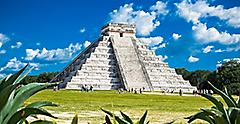
1. Chichen Itza
The sacred and pre-Hispanic city of Chichen Itza is one of the most famous Mayan ruins in Mexico, with a history spanning almost a thousand years. The structures are an example of fusion Mayan architecture and show how the Maya and Toltec people blended traditional Maya construction styles with highland and Puuc styles.
But Chichen Itza is more than just a famous ruin. It's also an ancient observatory and a place where the Maya could indulge in their sky-watching obsession. Proof of this love for astronomy can be found in the carvings that adorn the pyramids, where hieroglyphs depict the celestial cycles. El Castillo and El Caracol pyramids are perhaps the most astronomy-focused structures — both were built the way they were so their features would align with the moon, the rise of the planets, the solstices and the equinoxes.
Besides its beauty and history, Chichen Itza also holds many secrets. One of the most celebrated is the dormant giant snake that reveals itself across El Castillo at certain moments during the year. This deity is known as Kukulkan and appears to be climbing the pyramid's 365 steps during the spring and autumn equinoxes. Each step represents one day of the year.
Another Chichen Itza sacred secret is Cenote Sagrado, which is a hidden sinkhole beneath the site. It is believed that the cenote was used during Maya ceremonies, including during human sacrifices to the god of rain. Bones and jewelry have been found inside the sinkhole.

2. Palenque
UNESCO describes Palenque in Chiapas as a prime example of a Mayan sanctuary. The craftsmanship here is famous for its elegance, demonstrated in the sculpted reliefs, which portray typical Mayan themes. The interior spaces are wide with many openings. The space also includes galleries which are decorated with sculptures and stucco, something rarely seen in other ruins.
This is the place to visit to experience Mayan civilization ruins against a backdrop of Mexico's beautiful jungles. The sounds of Saraguato monkeys and parrots add to the magic of the temples of Palenque, and the road to the site is lined with beautiful and refreshing waterfalls. On the south side, you'll find the archaeological zone of Toniná, and in the east, across the Lacandona jungle, the ancient cities of Bonampak and Yaxchilán.
One of the most interesting things about Palenque is that the hieroglyphs here show the way the Maya communicated. Their words are carved all over the walls. Scholars have found this incredibly useful when researching the Mayan ancient logosyllabic writing system and finding a way to decode it. They found that the Maya living here wrote about trade, alliances and even war.
Book Now

3. Calakmul
Calakmul in Mexico is in the center of the Reserva de la Biosfera Calakmul, located near a lush jungle filled with parrots, toucans and turkeys. Hundreds of bird species call this magical place home along with Saraguato monkeys and howler monkeys. You might even spot a jaguar.
Many buildings from the original site survived in Calakmul. Because it’s very remote and because the dense forest almost completely conceals it, the site remained untouched for hundreds of years until American botanist Cyrus Lundell found it in 1931. The ancient city holds thousands of structures, and only a small percentage of them are currently excavated, restored and open to visitors.
In its glory days, Calakmul was home to about 65,000 people. The area included canals and reservoirs and the residents survived by using an intricate farming system. The Maya who lived here also depicted images of their daily life on murals, and some of these were only recently discovered.
The Great Pyramid is perhaps the most-visited and famous structure here. It has a base of about five acres and it's 175 feet high, making it the tallest in the Yucatán Peninsula.
4. Tulum
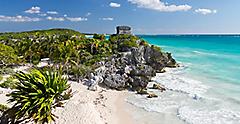
Tulum's Playa Ruinas, which are located in the Riviera Maya, is probably one of the most-photographed beaches in Mexico, likely because it's an idyllic backdrop for social media photos. Beach-seekers and yoga enthusiasts come here from around the globe and visit the famed ruins that are near a turquoise sea and bright white sand.
El Castillo is Tulum's most popular ruin and it's located on a clifftop, because its original purpose was to serve as a watchtower. El Castillo is almost as popular with tourists as Chichén Itza and Teotihuacan, and several of its Mayan temples and castles date back to pre-Columbian times.
These ruins may be on a smaller scale than others in Mexico, but Tulum more than makes up for this with its paradisiacal Mexican landscape. Tulum, also known as "the walled city," served as a trading port and some of its structures also date back to the Post-Classic period. When the Spanish arrived, Tulum was still a bustling city.
Don't miss the Temple of Frescoes, El Castillo and of course, the beach at Playa del Carmen, Akumal or any of the other popular ocean spots.
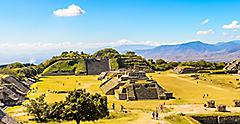
5. Monte Alban
Monte Alban was built on a hilltop and has panoramic views of the ruins of this once-dominant empire. It was inhabited for more than 1,500 years by Zapotecs, Olmecs and Mixtecs, all of whom predated and influenced the Maya. These groups built dams, canals, pyramids and mounds in Monte Alban, creating a fascinating topography. According to scholars, the buildings were built to withstand earthquake activity.
This UNESCO World Heritage Site has two distinct areas:
- Oaxaca de Juarez, the historic center.
- Monte Alban, home to the ruins.
The archeological section was founded around 500 B.C. and was the home of more than 30,000 people. It still has a ballgame court, observatory, religious temple, pyramids, tombs and drawings carved on hundreds of stones.
One unmissable area here is Plaza de los Danzantes, a square where petroglyphs of muscular men dancing can be seen. Scholars say the images depict men performing a ritual dance as a captured enemy is tortured. Other hieroglyphs show a calendar, including one that's aligned with the polar star that points to the north.
6. Teotihuacan
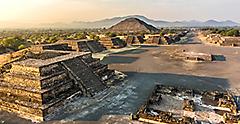
Teotihuacan is an ancient Mesoamerican site located north of Mexico City. It was settled around 400 B.C. and was one of the most powerful cities in the region. The city was lived in, then abandoned, by different groups for hundreds of years until it was discovered by the Aztecs in the 1400s. Its past is unknown, as is exactly who built the monumental site. However, its architecture, carvings and other aspects of the site resemble those settled by the Maya.
Teotihuacan contains many plazas, temples, pyramids and apartment compounds, and the most famous structures are the Pyramid of the Moon, the Pyramid of the Sun and the Temple of Quetzacoatl.
The religion of the people who inhabited Teotihuacan is difficult to discern because of the mystery surrounding the area, but its architecture demonstrates that this was a polytheistic society. The main deity was the Great Goddess of Teotihuacan, who is depicted as a spider.
The complex inspires all who visit because of its technological and architectural marvels. Many call Teotihuacan Mesoamerica's greatest city and a must-see on any Mexico vacation.
7. Ek Balam
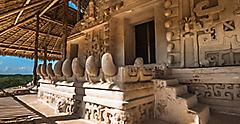
Ek Balam is a fascinating ancient Mayan city in Mexico, with a jungle still covering most of its structures. When you first see the area, it will probably remind you of movies you've seen. There's a ball court and arches surrounded by dense vegetation as well as the famous giant Acropolis, which is a restored gallery made up of different chambers.
Inside the Acropolis, paintings accompany the writing on the walls. One painting in particular, the Mural of the 96 Glyphs, is often called a masterwork of calligraphy. Other paintings depict mythological scenes, the moment of death and various deities.
Something to keep an eye out for is the sacbe arch, which is an ancient road that connected Ek Balam to other Maya kingdoms like Chichen Itza. These roads were common in many Mayan cities. If you go to the very top of the main temple, you'll be able to see Coba, another ancient city that was connected to Ek Balam by a sacbe.
The main pyramid in Ek Balam is a massive structure measuring 32 meters high. Its entrance was built to look like a huge jaguar mouth, and there are stucco sculptures surrounding the mouth that resemble skulls, Maya angels and shamans.
8. Uxmal
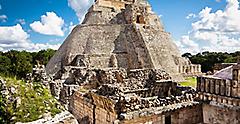
The Uxmal Mayan ruins is one of the most famous sites in Mexico. Uxmal means "built three times" in Mayan, and this refers to the intricate construction of the Pyramid of the Magician, which was built on top of other pyramids. It was the home of more than 25,000 people and catapulted to notoriety around 700-900 A.D. The Maya who built it were well-versed in astronomy, structuring the buildings around a ceremonial center called the Pyramid of the Soothsayer.
Many buildings were decorated with motifs and sculptures of Chaac, the god of rain. This god was particularly honored because Uxmal lacked natural water supplies. Unlike other ancient cities, this one was not built near a cenote. The inhabitants of Uxmal were desperate for water and revered Chaac in the hope of getting enough rain to support their city.
Scholars consider Uxmal to be one of the high points of Mayan architecture along with neighboring Ladbna, Sayil and Kabah. The most appealing parts of Uxmal are the ceremonial structures because they represent the pinnacle of Mayan achievement in design and art.
9. Coba
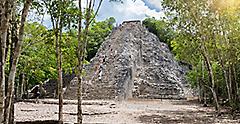
This ancient site is located in Quintana Roo, which is about 25 miles from Tulum. Coba means "water stirred by wind" and the city was first settled around 100 B.C. It's a beautiful, picturesque town surrounded by a bright green jungle. The ruins are spread out across the jungle but are easy to find. Originally, Coba was home to about 50,000 people and was famous for having a system of roadways, or sacbes, as well as many monuments. The ruins house two big lagoons and most of it remains unexcavated because of how recently it was rediscovered. In addition, excavation efforts were stalled by the Caste War and a lack of money to fund an excavation.
The main attraction in Coba is the ancient pyramid, which has 130 steps that visitors can hike up to reach the very top of the pyramid. For views of Yucatan, visit the Nohoch Mul Pyramid, where you can see the two lagoons as well as restricted areas like Macanxoc. Head to the Coba Group area to see the church or to Conjunto de Pinturas for a peek at the Pyramid of the Painted Lintel, which has a variety of artwork.
The monuments are located in Coba Stelae anddepict the clothes, rituals and roles of the people who lived there. The hieroglyphs also depict the social rituals and political structures of the inhabitants, including the dates of and stories about major events in the town.
Get Royal Deals, Sign Up Today
Related Articles

How To Plan A Cruise For The First Time
READ MORE

A Guide To Special Occasion Cruise Planning
READ MORE

How to Use Cruise Deck Plans
READ MORE






